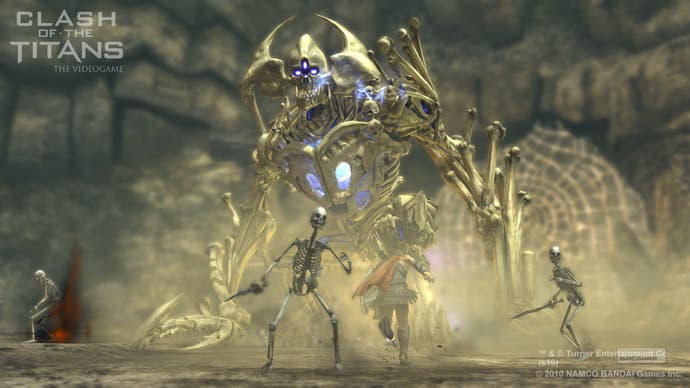Clash of the Titans
Hit or myth?
As soon as I heard that they were remaking Clash of the Titans, I knew there'd be a videogame. Obviously. So I booked a flight to South America, chartered a boat up the Amazon and tracked down the Tagaeri, a remote tribe that has had virtually no contact with the modern world. I made a bet with them, to see what they thought the Clash of the Titans videogame would be like. They said, "Probably another mediocre God of War rip-off, with giant boss monsters and probably a few quick-time events".
Well, looks like I owe the Tagaeri a family-sized bag of Haribo and the Friends DVD boxset. Clash of the Titans really is that predictable. Hemmed in by both the movie and Greek mythology itself, realistically there's a limit to how imaginative developer Game Republic could be under the circumstances, but that's no excuse for missing so many easy targets.
The game opens on a small fishing island, where Perseus lives with his adopted family, blissfully unaware that he's actually the illegitimate son of Zeus. His demigodly powers soon prove quite useful, however, as monsters and demons start to appear, along with soldiers from Argos (free delivery, you see) who are waging a war against the neglectful gods of Olympus.
And so you're introduced to combat, with the simple initial task of clearing a siren and some other monsters off the beach. In truly generic style, left trigger locks on, one button does the fast weak attack and another does the strong attack. Hit them in various ways and you perform combos that, on balance, are only slightly more effective than mashing one of them over and over again.

There is at least an attempt to add more wrinkles to the overly familiar cloth. While locked on you see that enemies glow in slightly different colours. Red means they're fresh and ready to fight. Wear them down a bit and they'll glow dark blue, meaning you can now perform the Soul Seize move, which syphons some of their life force for you to use in special attacks. Keep on clobbering and eventually they flash orange, which means they're softened up enough for the fatal Sub Weapon Seize attack.
Triggering this brings up a QTE-style mini-game in which you hit any button as a circle of orange energy whooshes across the screen. Hit it as the circle passes over two stationary markers and your attack is more powerful, yielding bonus goodies. Sub Weapon Seize allows you to steal weapons from enemies, and also other magical items. These secondary weapons are selected, four at a time, using the d-pad and map to a face button.

There are 80 such weapons in the game, each with its own tiers of upgradable stats and skills. Such generosity sounds great in theory, but ultimately proves that more isn't always better. Certain enemies can be instantly defeated with the right weapon, and there are monster-spawning obelisks that are even more specific in their requirements. In practice, this means a lot of journeys in and out of the game's clumsy, long-winded menu system to swap your arsenal around until you find the right tool for the job.
Upgrading proves problematic as well, since you need to collect Seize Points specific to the weapon type being augmented. If you want to level up a bow, you need to keep performing Sub Weapon Seize moves on archer enemies until you have enough, each time hitting the same timed button presses and watching the same slow-motion animation.








